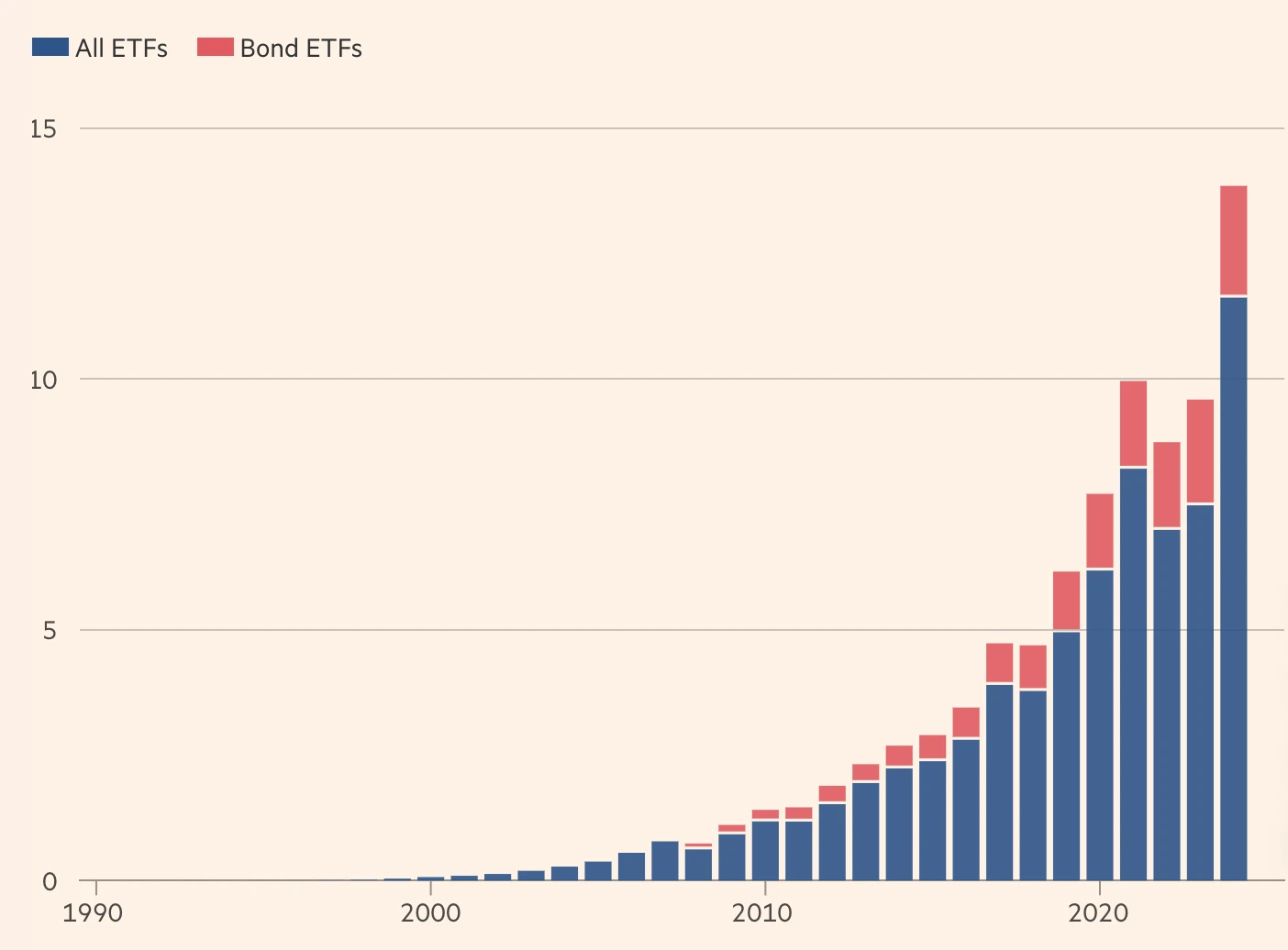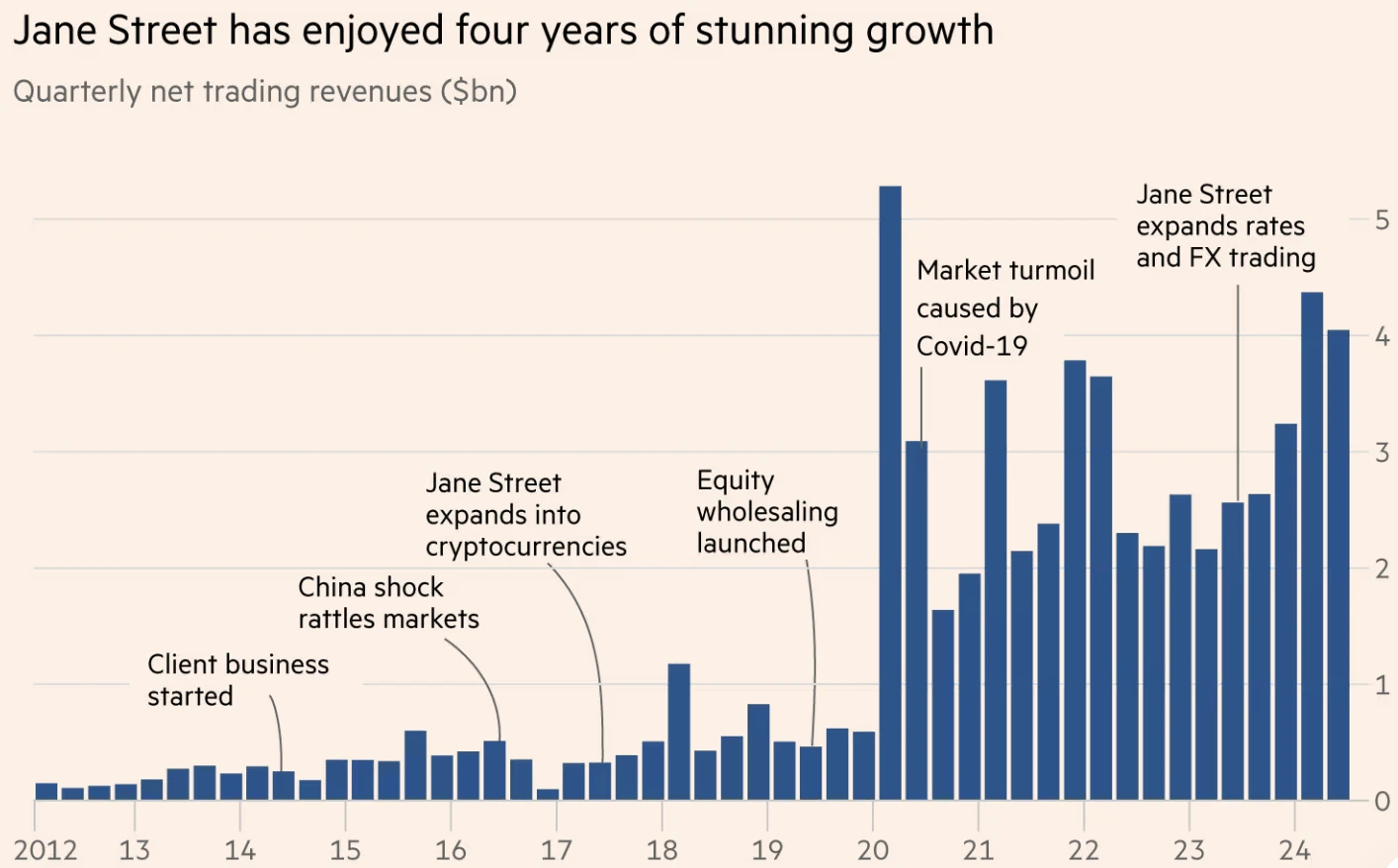عملاق وول ستريت الجديد: بفضل موجة الصناديق المتداولة في البورصة، أصبحت جين ستريت المتداولة الأكثر ربحية
المؤلف الأصلي: Will Schmitt Robin Wigglesworth
الترجمة الأصلية: TechFlow
Jane Street posted net trading revenues of more than $10 billion for the fourth year in a row last year, according to investor documents obtained by the Financial Times. Its $21.9 billion in total trading revenues were equivalent to about one-seventh of the combined revenues from stocks, bonds, currencies and commodities trading at the world’s 12 largest investment banks last year, according to Coalition Greenwich.
“Their profits are almost staggering. That’s because they deal in a lot of financial instruments that other people won’t touch,” said Larry Tabb, a longtime analyst of the industry who now works for Bloomberg Intelligence. “That’s where the biggest profits are, but the biggest risks are too.”
There are no signs that Jane Street’s growth will slow. Its net trading revenue in the first half of 2024 increased 78% year-on-year to $8.4 billion, according to people familiar with the matter. If it can maintain that level in the second half of the year, Jane Street’s full-year trading revenue will exceed that of the larger Goldman Sachs last year.
If it can maintain the 70% profit margin disclosed in the filing, Jane Streets revenue this year will easily exceed that of Blackstone or BlackRock, according to analyst forecasts compiled by LSEG.
Jane Street has been particularly strong in the bond market, where it has quickly made inroads into an area long dominated by banks and previously considered inaccessible to independent trading firms.
“You can think of the evolution of Jane Street as a process of automation, where we take on more complex tasks and then automate them,” Matt Berger, head of fixed income at Jane Street, told the Financial Times. “That’s the evolution of our business.”
However, Jane Street also faces many internal and external challenges.
Jane Street has set off a wave of ETFs
The once-low-profile trading firm is now one of the most closely watched businesses in the industry, and thats making many Jane Street employees uncomfortable. Rapid growth is testing its flat, academic organizational structure. Competitors are trying to poach its best employees. And some investors worry that Jane Streets key intermediary role in the rapidly expanding bond ETF market could make it systemically important.
Meanwhile, rivals are fighting back, with banks trying to block its expansion in fixed-income markets and Citadel Securities eyeing Jane Street’s success in corporate bonds.
“This is the classic innovator’s dilemma,” said one former Jane Street employee. “When they were the underdog, they moved fast and innovated in ways that no one else could. Now that they’re big, others are going to catch up.”
Jane Street was founded in 2000 by a couple of traders from Susquehanna and a former IBM developer. For its first two decades, it was content to grow in obscurity behind older, better-known trading firms like Virtu Financial and Citadel Securities.
It started out trading American depositary receipts — shares of foreign companies traded in the U.S. — in a small windowless office on the now-defunct American Stock Exchange. But it soon expanded into options and ETFs, the latter of which Amex had pioneered a few years earlier.
ETFs were still a niche market, with only about $70 billion in assets when Jane Street began trading. However, ETFs quickly became its main business, and over time it became a significant “authorized participant,” a market maker that could create and redeem ETF units in addition to trading them.
Jane Street excels particularly in the nonmainstream ETF space. Former and current executives say the firm’s love of puzzles — part of its sophisticated interview process — reflects its willingness to take on more challenging trading challenges, such as handling ETFs in less liquid markets such as corporate bonds, Chinese stocks or exotic derivatives.
That means speed isnt as important at Jane Street as it is at Jump Trading, Citadel Securities, Virtu or Hudson River Trading, even though the firm is often classified as a high-frequency trader.
On a spectrum from the intuitive traders at investment banks’ “proprietary trading desks” before 2008 to pure technology firms like Citadel Securities or Jump Trading, Jane Street is closer to the middle, according to insiders and competitors. The firm sometimes holds positions for days or even weeks.
“It’s an interesting combination of technology and street smarts,” said Gregory Peters, co-chief investment officer of PGIM Fixed Income.
Investing in ETFs has proven to be a smart move as the industry has enjoyed a long boom. ETF assets are now approaching $14 trillion, according to data provider ETGI. Jane Street has gradually gained favor with bright minds looking to earn good paychecks—one of the reasons it attracted a young MIT graduate, Sam Bankman-Fried, to the firm in 2013.
Yet even within its industry, it is known for its unique use of OCaml, a programming language used to build nearly every system. To the outside world, it remains a mystery (fittingly, Jane Street has an original Enigma machine at its New York headquarters).
Its anonymity is so strong that three of the four co-founders retired quietly with little notice from the outside world, leaving the last, Rob Granieri, known by insiders as the first among equals. But Jane Street has no CEO, and in loan documents shared with investors, the company describes itself as a functional organizational structure consisting of various management and risk committees.
Each trading desk and business unit is headed by one of 40 equity holders who collectively own $24 billion of Jane Street stock. Granieri is seen more as a low-profile, long-haired Silicon Valley actor than a billionaire trading tycoon, but Jane Street employees say big decisions are made by a broader collective leadership group, a structure that fosters collaboration and reduces layers.
ويتجلى هذا في هيكل الأجور الذي تتبناه الشركة ــ إذ لا تربط شركة جين ستريت الأجر بأرباح التداول الفردية، أو حتى بأرباح المكتب الذي يعمل به الموظف. كما تتجنب الشركة منذ فترة طويلة استخدام الألقاب الرسمية، حتى وإن كان هذا قد يسبب بعض الارتباك خارج الشركة.
In the early days, when you got these people together in a room, they didnt give you business cards, they were all in shorts and T-shirts, and you had no idea who you were talking to, recalls Bloombergs Tabb.
However, Jane Street’s low-key image began to change in 2020 as its huge profits in the coronavirus-turbulent markets made headlines.
Its profits even surpassed those of Ken Griffin’s Citadel Securities, drawing widespread attention, and rumors of huge payouts sparked jealousy on Wall Street. Marking its debut on the biggest stage, in September 2020 the Federal Reserve added Jane Street to its list of acceptable counterparties for its crisis response, alongside Wall Street stalwarts like JPMorgan.
Jane Street subsequently received widespread attention for being the place where Bankman-Fried began his trading career before founding the now-defunct cryptocurrency exchange FTX. This publicity unnerved many at Jane Street, especially since Bankman-Fried’s risk-taking and compliance-focused approach, which landed him in jail, was seen by many insiders and outsiders as antithetical to Jane Street’s ultra-cautious style.
In addition to having a 14-person central risk center that continuously monitors all of its volatile exposures, Jane Street also maintains an additional “liquidity buffer” of about 15% of trading capital.
This reserve fund, held outside its prime brokers, is designed to ensure that Jane Street can maintain its positions even if markets are disrupted. In addition, the firm makes extensive use of derivatives to hedge against both small idiosyncratic shocks that could affect a single trading desk and broad financial crises that could shake an entire firm.
Jane Street was in the spotlight again earlier this year when it sued two former traders who left for hedge fund Millennium Management in February. Jane Street said in court documents that it was losing more than $10 million a day as the Indian options strategies the traders allegedly took away soured. Since then, the two firms have been engaged in a legal battle to determine who needs to provide which documents.
Still, the attention hasn’t slowed Jane Street’s growth. Its rapid growth in trading revenue shows its growing influence in the stock and options markets. In the coming year, the company plans to expand further in government bonds and currency trading, and significantly increase the scope and ambition of its machine learning efforts in terms of staff, infrastructure, and computing power, according to Berger.
Jane Streets profit growth boosts firms value
However, Jane Street’s core business remains ETFs. Last year, Jane Street accounted for 14% of ETF trading in the U.S. and 20% in Europe, according to documents the company shared with lenders. In the bond ETF space, Jane Street estimates it accounts for 41% of all creation and redemption transactions.
This market dominance enables Jane Street to tap into the underlying bond market, which has traditionally been dominated by banks, and is a key differentiator from its peers.
“Technology companies that can price in real time and react quickly will make more money,” said Alexander Morris, chief investment officer at F/m Investments, which uses Jane Street as a market maker for its bond ETFs. “Because they are faster and provide fairer prices, their goal is to close the trade quickly and move on to the next one, not to get paid extra for delaying the trade.”
However, after a few bumper years, Jane Street appears to be facing more pressure.
Many banks have been investing aggressively in technology and restructuring their trading teams to counter competition from firms like Jane Street, both in equities and bonds. Those efforts are starting to pay off. “They’ve closed a lot of the gaps,” he said.
Adam Gould, global head of equities at Tradeweb, said. Meanwhile, Citadel Securities — already a big player in the government bond market — is also starting to get involved in the corporate debt market. “Competition has definitely increased, and I think that’s good for the overall market environment and for investors,” Berger said.
Jane Street’s biggest challenge, however, may be internal. Maintaining a collaborative, nonhierarchical culture was relatively easy when all employees could work on one floor in New York. But as of the end of last year, the company had 2,631 full-time employees, nearly half of whom were spread across offices from Singapore to Amsterdam.
This is one reason why Millennium’s poaching has attracted attention. As Jane Street grows in size and becomes less cohesive, it could lose more employees and increase the risk of its strategy being leaked, a challenge for a company that has historically performed well.
A former Jane Street employee noted: Even in bad years, Jane Street still paid its employees well. But then the company only had 100-200 people. Now the company has to support nearly 3,000 people.
If Jane Street has a bad year, it will have a significant impact on the company. If it has a mediocre year, the company will be in a very big trouble, which will put the company in a precarious situation.
This article is sourced from the internet: Wall Streets new giant: Riding the ETF wave, Jane Street is becoming the most profitable trader
On October 8, Bitlayer, the first Bitcoin second-layer project based on Bitcoin finality, announced the completion of a $9 million Series A+ financing round led by Polychain Capital and co-led by Franklin Templeton. Other participating investors include SCB Limited, Selini Capital, G-20 Group and other well-known institutions. This round of financing is the latest fundraising after Bitlayer completed a $5 million seed round of financing in March this year and a $11 million Series A round of financing in July this year. As of now, Bitlayers investment institutions have covered Framework Ventures, ABCDE, Franklin Templeton, StarkWare, OKX Ventures, Alliance DAO, UTXO Management and other investment institutions. After the completion of this round of financing, Bitlayers total financing has reached 25 million US dollars. The team will expand Bitlayer to a…










